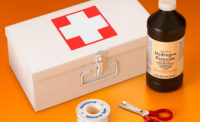When it comes to needles, no matter the size, from the smallest 33-gauge hypodermic needle to the biggest 7-gauge needle, it’s safe to assume that no one wants to accidentally get pricked by one.
The risk of infection after a contaminated needle stick varies by the bloodborne pathogen. According to the Canadian Centre for Occupational Health and Safety “the risk of transmission after exposure to HIV-infected blood is about 0.3%, whereas it is estimated to be up to 100 times greater for hepatitis B virus (30%) and could be as high as 10% for hepatitis C virus.”
HIV, of course, is the virus that causes AIDS. The virus attacks the immune system and weakens the body to the point where it can’t fight off diseases. One way of contracting the deadly virus is through a needle stick caused by an HIV-contaminated needle.
Hepatitis B (HBV) is a virus that affects the liver and causes flu-like symptoms. In most cases, Hepatitis B goes away on its own, but sometimes the condition becomes chronic. A person may be contaminated by the blood of someone who carries the virus, thus a contaminated needle is a risk factor.
Hepatitis C (HCV) is considered to be a serious condition, damaging the liver severely and may even lead to liver failure and liver cancer. Hepatitis C is spread through contact with blood contaminated with the virus, for example on a discarded hypodermic needle.
Needlestick injuries on the job
Naturally, most accidental needle sticks happen in the healthcare industry. Other high-risk work environments where needle sticks are frequently reported are garbage removal and recycling facilities, custodial, housekeeping, parks and recreation, cleaning and tattoo shops. But there are many other instances where accidental needle sticks may occur.
Sometimes it’s in places highly improbable, for instance trash receptacles or the outside grounds of an industrial facility, or even an unmarked container. It’s important to always keep in mind different risk factors while at work. One can never be too careful as appropriate hand protection becomes necessary.
A report published in 2011, by the International Healthcare Worker Safety Center, University of Virginia, showed that 43 percent of needle stick injuries happened from different kind of syringes, of which 37 percent of accidents came specifically from disposable syringes.
Of all needle specific injuries recorded, 59 percent were superficial (little to no bleeding), while 39 percent were moderate (skin punctured, some bleeding).
69 percent of the injuries happened while the worker wore a single pair of gloves and 18 percent while wearing double pair of gloves. 13 percent wore no gloves at all.
One number in particular jumps out as a major red flag: 69 percent of workers who wore gloves still injured themselves by needle stick.
Assuming they followed protocol by wearing gloves, the data clearly shows the gloves worn were not able to prevent hypodermic needle sticks from happening. This finding indicates the need to reevaluate the kind of protective gloves given to safety workers. In fact, there should be a standard. A perfect scenario is one where gloves should be rated for 28-gauge hypodermic needle protection to ensure safety on the job. It sounds simple enough, yet there are no regulations for minimal hand protection required in the workplace.
A survey of needle exchange programs in the U.S., sponsored by the National Institute of Justice (NIJ) and Technical Support Working Group (TSWG), found the most popular needle used by drug addicts by far was the 28-gauge needle. This is one of the smallest and most difficult needles to stop. The fine point of the hypodermic needle creates a puncture and cuts through nitrile, latex and vinyl barrier gloves, as well as finding its way through gaps in string knit gloves that do not specifically identify protection for 28-gauge needles.
Workers’ exposure to needles
To avoid dangerous exposure and potentially life-threatening injuries, workers who are at high risk of accidental needle sticks rely on hand protection as the number one defense. A glove’s protective properties, such as cut and puncture resistance, thus become important factors to consider when choosing hand protection. Most cut injuries start with a puncture.
Workers in the recycling industry spend their time in an environment where they have to wear protective gloves close to 100 percent of the time. It becomes necessary to go beyond just cut and puncture in order to address a glove’s effectiveness for the task at hand.
Recycling workers encounter discarded needles
on a daily basis. Contaminated or not, these workers better keep their gloves on while performing their work. A glove’s dexterity and thickness become key factors. A dexterous, thin glove is flexible and moves easily. What kind of glove is more likely to stay on all day long — a lightweight glove that’s easy to work with or a thick and bulky glove that fatigues your hand?
In addition to knowing that a glove has the right level of protection, it’s important to understand the protection coverage area that’s needed for a specific task. If a plumber reaches into a blocked sewage line, is it enough that he or she only wears a glove with excellent needlestick protection on the palm? Probably not. The safer bet would be to wear a full coverage glove, or at least a glove with additional fingertip wrap to protect from accidental sticks.
The Needlestick Safety and Prevention Act
Occupational exposure to bloodborne pathogens from accidental sharps injuries in healthcare and other occupational settings continues to be a serious problem. Congress signed into law The Needlestick Safety and Prevention Act (Pub. L. 106-430) on November 6, 2000. The Act requires “employers to identify, evaluate, and implement safer medical devices. The Act also mandates additional requirements for maintaining a sharps injury log and for the involvement of non-managerial healthcare workers in evaluating and choosing devices.”
However, OSHA will not approve or endorse any products. It is the employer’s responsibility to determine what is appropriate for specific hazards, based on what is feasible and commercially available.
The Act is a great start and a good guide for occupational safety. To reduce the risk of exposure to bloodborne pathogens, a plan should be implemented
by the employer. This plan should detail employee protection measures. The use of personal protective equipment (PPE), training, signs and labels, as well as medical supervision (if needed) are all good examples of ways to reduce accidental needle sticks that high-risk workers face on the job.



